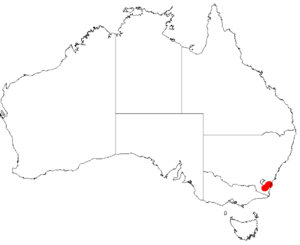Kydra wattle facts for kids
Quick facts for kids Kydra wattle |
|
|---|---|
| Scientific classification | |
| Genus: |
Acacia
|
| Species: |
kydrensis
|
 |
|
| Where Kydra wattle grows in Australia | |
The Kydra wattle (Acacia kydrensis) is a type of shrub. It belongs to the Acacia family, also known as wattles. This plant is special because it only grows in a specific area of southeastern Australia. This means it is endemic to that region.
What Kydra Wattle Looks Like
This shrub usually grows to be about 1 to 2 meters (3 to 6.5 feet) tall. It has many stems and smooth, reddish-brown branches. Like most Acacia plants, it doesn't have true leaves. Instead, it has phyllodes. These are flattened leaf stalks that look and act like leaves.
The phyllodes are attached to small bumps on the branches. They stand upright and are shaped like a narrow spoon. They are about 3 to 6 centimeters (1.2 to 2.4 inches) long and 9 to 14 millimeters (0.35 to 0.55 inches) wide. Each phyllode has a clear central vein and veins along its edges.
The Kydra wattle usually blooms between September and November. Its flowers grow in round clusters, like little balls. Each cluster has 15 to 24 yellow flowers.
After the flowers, dark brown or black seed pods grow. These pods are smooth and can be up to 8 centimeters (3.1 inches) long. They are about 5 to 8 millimeters (0.2 to 0.3 inches) wide. Inside, the seeds are black and dull or slightly shiny. They are about 4 to 4.5 millimeters (0.16 to 0.18 inches) long. Each seed has a reddish, club-shaped attachment called an aril.
How Kydra Wattle Was Named
A botanist named Mary Tindale first officially described the Kydra wattle in 1980. Botanists are scientists who study plants. She wrote about it in a scientific journal called Telopea.
Later, in 2003, another botanist named Leslie Pedley reclassified it. But in 2006, it was moved back to the Acacia group. The first plant sample used to describe the species, called the type specimen, was collected in 1974. It was found by R.G. Coveny at Kydra reefs.
Where Kydra Wattle Grows
The Kydra wattle is found in central New South Wales, Australia. It grows in the Kydra reefs area, which is southwest of Cooma. You can mostly find it in Deua National Park and Wadbilliga National Park.
This plant prefers rocky areas, like outcrops or gullies. It grows in stony, sandy soils. These soils often contain rocks like granite, rhyolite, and slate. It is usually part of dry sclerophyll forest and shrubland communities. Sclerophyll forests have plants with hard, tough leaves that help them survive dry conditions.

